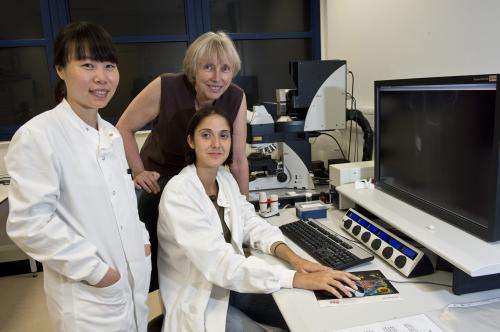Moving genes have scientists seeing spots

An international team of scientists led by the UK's John Innes Centre and including scientists from Australia, Portugal, China and Italy has perfected a way of watching genes move within a living plant cell.
Using this technique scientists watched glowing spots, which marked the position of the genes, huddle together in the cold as the genes were switched "off".
"The movement of genes within the nucleus, captured here using live imaging, seems to play a role in switching their activity on and off", said first author Dr Stefanie Rosa from the John Innes Centre.
"In our study, we tracked genes involved in accelerating flowering in response to cold, but the movement of genes could be important in all areas of biology."
"Studying gene motion could improve our understanding of how environmental cues and nurture impact on nature and gene expression."
The research will be published on Thursday in the international journal Genes & Development.
"What is remarkable about this finding is that we saw genes move in response to changes in the environment, and that this movement seems to be involved in genetic control," said Associate Professor Josh Mylne.
He initiated the approach almost 10 years ago as he embarked on his career at the John Innes Centre and is now an ARC Future Fellow at The University of Western Australia's School of Chemistry and Biochemistry and the ARC Centre for Excellence in Plant Energy Biology.
"The gene we studied (FLC) allows plants to respond to changes in the season. When FLC gets turned off (by cold), the plant starts to make flowers instead of leaves. We knew FLC was switched off by cold, but we had no idea that FLC genes would congregate as they get switched off."
Previous to this research, plant genes were studied by cutting up plants, killing the cells and fixing them to glass slides. Researchers can now watch genes move inside living plants.
Although the study is of interest to researchers by providing an understanding of how FLC moves as it is turned off, it can be applied to any gene in plants or animals. The major benefit of this approach is that it allows researchers to monitor a gene in whole, living organisms.
"What we want to know now is what is happening at these sites where the genes are congregating," Associate Professor Mylne said. "Are the genes going somewhere special inside the cell? What takes them there and how do the chromosomes move and let the genes congregate? How many other genes congregate like this when they get turned off?
"There are so many new questions this discovery will help us answer."
More information: www.genesdev.org/cgi/doi/10.1101/gad.221713.113
Journal information: Genes & Development
Provided by John Innes Centre

















